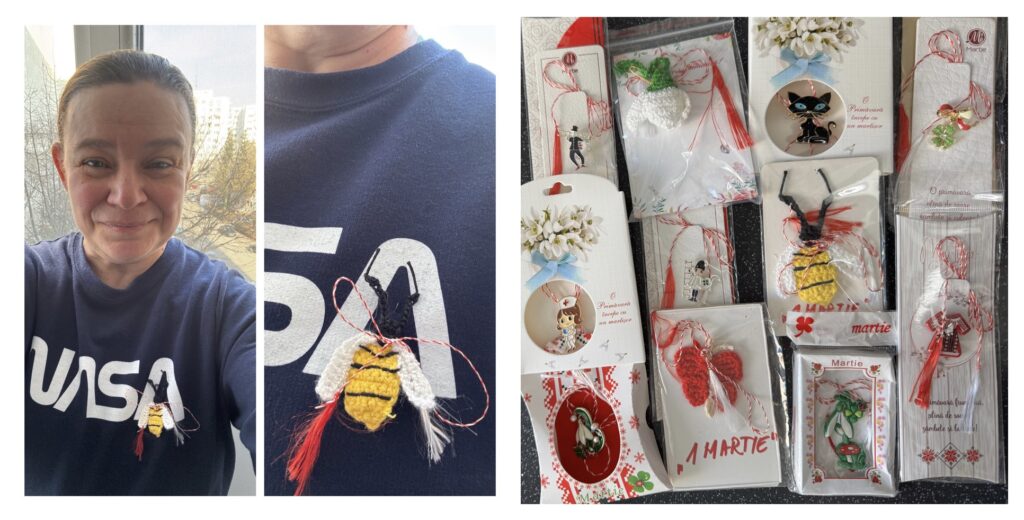Mărțișor, celebrated on March 1st, is a cherished Romanian tradition that marks the arrival of spring and symbolizes renewal, hope, and good fortune. As a Fulbrighter in Romania, I have the unique opportunity to experience this tradition firsthand, witnessing how cultural heritage remains deeply embedded in everyday life. More than a simple red-and-white trinket, Mărțișor carries centuries of history and meaning, serving as a reminder of resilience, optimism, and the changing seasons. While I was familiar with the custom before coming to Romania, living here has given me a deeper appreciation for its significance and how it connects people through shared traditions.
Origins and Meaning of Mărțișor
The tradition of Mărțișor dates back thousands of years, with roots in ancient Roman and Dacian celebrations of the new year, which once began in March. The name itself derives from “Marț,” the Romanian word for March, and translates to “Little March.” Historically, Mărțișor was a decorative object and a protective talisman believed to bring health, luck, and prosperity. Traditionally, it was made from a simple red and white wool thread, often tied around the wrist or neck, sometimes with a small gold or silver coin attached. The red color represents life, vitality, and the struggles of winter, while the white symbolizes purity, wisdom, and the promise of spring. Another interpretation suggests that the red stands for courage and sacrifice, while the white embodies hope and victory, a duality reflected in many Romanian legends.
One of the most well-known legends associated with Mărțișor tells the story of a young hero who fought a dragon that had kidnapped the Sun, keeping it locked away and plunging the world into darkness. After a long and challenging battle, the hero freed the Sun, restoring light and warmth to the world. However, he was mortally wounded in the process, and as he lay dying, his blood stained the snow. From where his blood fell, the first snowdrops, Romania’s symbolic flower of early spring, began to bloom. The intertwined red and white threads of the Mărțișor represent this sacrifice and the renewal of life that follows.
The Evolution and Cultural Reach of Mărțișor
Over time, the tradition of Mărțișor has evolved, with the simple thread being replaced by decorative brooches, pendants, and bracelets featuring charms in the shape of flowers, four-leaf clovers, ladybugs, and other symbols of good luck. The custom is still widely practiced today, not only in Romania but also in Moldova and parts of Bulgaria, where it is known as Martenitsa, as well as in Macedonia and Serbia. In contemporary Romania, Mărțișor is primarily given to women by men, colleagues, friends, and family members as a token of appreciation and good wishes. It is often worn throughout March before being tied to the branch of a blossoming tree, a gesture believed to bring good fortune and prosperity. In recognition of its cultural importance, Mărțișor was included in UNESCO’s List of Intangible Cultural Heritage of Humanity in 2017.
Experiencing Mărțișor as a Fulbrighter
Experiencing Mărțișor as a Fulbrighter adds another meaning to my time in Romania. It is a tradition that reflects the kindness and hospitality I have encountered here. Much like the act of offering a Mărțișor, my experience has been shaped by gestures of generosity, openness, and cultural exchange. As a researcher in the Danube Delta, I continually learn how deeply culture and environment are connected. While my work focuses on human security, I also recognize the importance of traditions in shaping resilience and identity. Mărțișor is a celebration of spring and a symbol of continuity, reminding people of their ties to the past and their hopes for the future.
As March 1st approaches, I look forward to giving and receiving Mărțișor and fully participating in this tradition as an observer and as someone becoming part of Romania’s cultural fabric. In many ways, Mărțișor embodies what being a Fulbrighter is all about: building connections, appreciating cultural heritage, and embracing new experiences with an open heart. This journey has been one of academic and personal discovery, and engaging with traditions like Mărțișor deepens my understanding of the country and its people.
Sources
Sărbătoarea Mărțișorului – origine și tradiții. Available at: https://www.radioromaniacultural.ro/sectiuni-articole/istorie-filozofie-psihologie/documentar-sarbatoarea-martisorului-origine-si-traditii-id4358.html
Mărțișor – Wikipedia. Available at: https://ro.wikipedia.org/wiki/M%C4%83r%C8%9Bi%C8%99or

